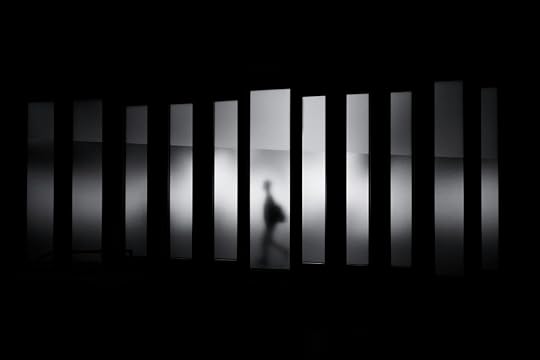Adam Fenner's Blog, page 18
November 9, 2024
Shadows
Avinight
Shadows I can see,of things that are gonna be,
Shadows left behind,
because they aren't needed, right?
Reflections they show,
Of Future,
…
You may find the rest of the poem here.
Analysis
In the poem “Shadows,” the speaker challenges the common view that shadows are dark and negative, encouraging readers to see them instead as evidence of light. The central idea of the poem is that shadows are not to be feared or avoided, but rather, they are the natural result of light. The speaker asks us to reconsider our assumptions about shadows and understand them as part of a greater balance between light and darkness.
At the core of the poem is the relationship between light and darkness. Shadows, often viewed as dark or even sinister, are shown to be proof of light’s presence. The speaker writes, “They are considered dark, / even though, / they prove, / the presence of light.” This challenges the traditional view of shadows as something negative. Instead, the poem suggests that shadows exist because light is shining on an object, and thus, shadows should be seen as signs that light is at work, not as symbols of evil or absence.
“Shadows” touches on the impermanence of…shadows. The speaker mentions that shadows represent things that are “gonna be” or “left behind,” highlighting their temporary and shifting nature. Just like moments in life, shadows change constantly, reflecting the past, present, or future. This idea deepens the theme of shadows being more than just dark shapes; they are fluid, always in motion, and always tied to the presence of light.
The poem’s structure mirrors the theme of shifting shadows. It follows a free verse form, with no set rhyme or rhythm. This lack of structure reflects how shadows change shape and appearance based on the light around them. The short, fragmented lines create a sense of movement, echoing how shadows are not fixed but fluid, adapting to the light source. The simplicity of the language makes the poem feel reflective and accessible, inviting readers to think about shadows in a deeper way without distraction.
The straightforward language also helps convey the poem’s main message clearly. The speaker doesn’t use overly complicated metaphors, but instead keeps the focus on the idea that shadows are a natural part of life, created by the light. This direct approach helps readers engage with the poem’s ideas and understand that shadows should not be feared, but recognized as evidence that light is present.
This piece also reflects the author’s personal experience of being misjudged. The speaker compares the misunderstanding of shadows to how people are often judged based on surface-level impressions. Just as shadows are wrongly seen as dark or negative, introverted or quiet people can be misjudged as unfriendly or rude. The poem encourages readers to question their biases and reconsider how they perceive both shadows and people. The speaker asks, “Who said shadows are bad?” to challenge us to think about why we view certain things in a particular way.
The tone of the poem is calm and reflective. The speaker is not trying to make an aggressive argument but rather gently invites the reader to reconsider their views. The poem’s message is one of acceptance and understanding, suggesting that shadows, like people, have value and purpose. Shadows are not negative; they are a result of light, and we should appreciate them as part of the natural balance in the world. The poem encourages us to embrace the presence of shadows as proof that light exists and is shaping the world around us.
“Shadows” is a thoughtful poem that uses the image of shadows to explore the balance between light and darkness. Through its simple structure and language, the poem challenges readers to reconsider their assumptions about shadows and to see them not as dark or negative, but as proof of the presence of light. The poem encourages us to look beyond surface appearances and recognize the deeper connections between light, darkness, and the world around us. Ultimately, it reminds us that shadows are not to be feared but celebrated as part of the larger flow of light in our lives.

Photo by David Werbrouck on Unsplash
November 8, 2024
Water, Beautiful Water
Chris Hall
shall we go?
we have wooden boats
five of us
we will row
gently but swiftly
here we go;
…
You may find the rest of the poem here.
Analysis
In “Water, Beautiful Water,” the speaker creates a peaceful scene in nature, where clear water, tall mountains, and deep air come together to form a calm and beautiful moment. The poem’s imagery captures the simple beauty of nature, but it also reminds us that such moments are brief. This mix of peace and the awareness of time passing gives the poem a bittersweet tone.
The poem starts with a simple yet powerful image: five people in wooden boats, gently rowing across clear water. The wooden boats suggest a humble connection to nature, while the clarity of the water reflects the beauty of the surroundings. The image of the mountains “staring up” brings the landscape to life, making the mountains seem like quiet, watchful companions to the rowers. This anthropomorphism suggests that the mountains are timeless, always present, and unmoved by the passing of time, which contrasts with the rowers’ awareness that their moment on the water is limited.
The line “air breathes deep” connects the rowers with the natural world around them. The breath of the air gives a sense of life and vitality, adding to the feeling of harmony in the scene. The repeated word “row” mimics the calm, steady motion of rowing, reinforcing the peaceful atmosphere. The use of words like “lovely” and “wonderful” shows the speaker’s deep appreciation for the beauty of the moment.
However, despite the calm beauty of the scene, the speaker soon acknowledges that time is running out. The final line, “such a shame we only have an hour,” shifts the tone from peaceful enjoyment to quiet regret. This line reminds us that even the most beautiful moments in nature are temporary. The word “shame” highlights the sadness the speaker feels about how quickly time passes. The briefness of the hour becomes a symbol for how time often feels too short when we are fully immersed in a beautiful moment.
The poem’s simple structure and steady rhythm reflect the gentle motion of the boats, while the repetition of “row” adds to the feeling of time moving forward. The tone of the poem starts with contentment but shifts to a sense of loss, reminding us that peaceful moments don’t last forever. Overall, “Water, Beautiful Water” captures the fleeting nature of time, encouraging us to appreciate the present while recognizing that it will soon slip away.

Photo by Mukul Joshi on Unsplash
November 7, 2024
The Emotion Journal [ Haikus!]
Joy
My heart has grown wings,
It’s ebullience, I think,
My first time feeling it …
Sadness
The rain, like tears,
A squall opens my casement,
I’m too grieved to care.
…
You may find the rest of the five haiku’s here.
Analysis
This collection of five haikus captures five different emotions—joy, sadness, pain, anger, and fear—using simple language and strong imagery. The poet explores each feeling with emotional honesty, making the poems feel relatable and immediate. By focusing on how these emotions feel in the body and in the mind, the poet invites readers into a direct experience of each one.
The haiku on joy expresses a sudden burst of happiness. “My heart has grown wings” suggests a feeling of lightness, as if the speaker is soaring with joy. The phrase “I think” adds a sense of uncertainty, as though the speaker is still figuring out this new emotion. This moment of discovery, rather than a boastful declaration of happiness, shows how even joy can be surprising and complex. The tone is uplifting, capturing the feeling of self-discovery.
In the sadness haiku, rain is used as a metaphor for tears, creating a connection between the weather and the speaker’s inner world. The “squall” represents a sudden, overwhelming storm of grief. The line “I’m too grieved to care” reveals emotional exhaustion, where the speaker feels numb and detached from the world around them. This raw expression of grief, where even the storm outside is met with indifference, conveys how sadness can feel all-consuming.
The haiku about pain uses the image of blood trickling, even though the wound is “invisible.” This speaks to emotional or psychological pain, which is often hidden but just as real as physical injury. The line “How could they do this?” suggests the speaker’s hurt is caused by betrayal or confusion. The stark imagery of blood makes the pain feel immediate, even though it is not something others can see. The tone is one of deep hurt and questioning.
In the haiku about anger, the speaker struggles with how to manage their wrath. “If I free my wrath” shows a desire to release the anger, but the question “Will it come, my turn?” reveals uncertainty about whether it’s the right time or if it will have consequences. The line “the word will burn” uses fiery imagery to show how anger can be destructive if not controlled. The poem captures the tension of wanting to express anger but not knowing if it will be safe or helpful to do so.
The fear haiku brings the reader into the speaker’s anxious state through physical sensations like a racing heart and trembling lips. The repetition of “please” in the final line increases the urgency and vulnerability of the moment. The speaker’s plea “Don’t hurt me” makes the fear feel raw and unguarded. This haiku captures the power of fear by focusing on how it physically manifests, showing the speaker’s complete vulnerability.
What makes these haikus so impactful is the poet’s emotional honesty and use of strong imagery. The poems don’t shy away from difficult emotions but present them plainly, inviting the reader to experience them fully. Each haiku uses simple yet powerful imagery to make the emotions come alive, whether it’s the lightness of joy, the heaviness of sadness, the hidden pain, the intensity of anger, or the vulnerability of fear. These haikus offer a glimpse into the speaker’s emotional world, allowing the reader to connect with these feelings in a real and personal way.

Photo by Milada Vigerova on Unsplash
November 6, 2024
Pieces of Panic
When my world comes crashing down
there’s no ocean deep enough for my sorrows to drown
The air feels heavy and thick
settling on my chest like a heavy brick
The fire inside me dwindles to a flickering ember
leaking memories that I try not to remember
The ground beneath my feet cracks apart
the fractures echoing all the way to my heart
The vice-like grip around my heart tightens its hold
chasing the warmth away, leaving me powerless against the cold
…
You may find the rest of the poem here.
Analysis
Pieces of Panic offers a raw and emotional portrayal of an anxiety attack, using powerful imagery to capture both the physical and mental experience of overwhelming fear. The poem focuses on the feeling of being trapped inside one’s own mind, suffocated by intense emotions, memories, and thoughts. The speaker’s journey through panic is one of chaos and confusion, but it also hints at the possibility of finding peace, making it a relatable exploration of the struggle to regain control during a mental breakdown.
The central theme of Pieces of Panic is the battle against anxiety and emotional collapse. The speaker describes how they are consumed by internal fears, unable to escape the tight grip of panic. The poem highlights the physical weight of anxiety, with phrases like “the air feels heavy and thick, settling on my chest like a heavy brick,” which communicate the suffocating feeling that often accompanies an anxiety attack. The metaphor of “a vice-like grip around my heart” further emphasizes the physical and emotional constraint that comes with panic, where the speaker feels trapped and powerless against their fear.
Despite the overwhelming feelings, there is a glimmer of hope in the poem. In the final lines, the speaker speaks of “chasing a distant flicker of hope,” suggesting that even in the midst of panic, there remains a possibility for peace and calm. This shift offers a sense of resilience, implying that hope, however small, can provide a way out of the storm of anxiety.
The poem’s imagery is key to communicating the intensity of an anxiety attack. The early lines describe the physical effects of panic, like the heavy pressure on the chest, symbolized by “settling on my chest like a heavy brick.” This image immediately evokes the sensation of tightness and shortness of breath, common during an anxiety attack. Similarly, the line “the fire inside me dwindles to a flickering ember” represents the emotional exhaustion that often accompanies anxiety, where the speaker feels drained and devoid of energy.
As the poem continues, the imagery becomes more chaotic, mirroring the speaker’s mental state. The ground “cracks apart,” symbolizing the loss of stability and control, while the speaker’s thoughts “crash into fears,” reflecting the overwhelming nature of anxiety. The sense of disorientation is amplified with the line “shapes and colours spin and blur in my vision,” which conveys the confusion and distortion that often accompanies a panic attack.
Despite this chaos, the speaker searches for an anchor, something to hold on to, as a way to regain control. The anchor metaphor represents the need for stability and grounding in the midst of overwhelming fear.
The free verse structure of the poem effectively reflects the unpredictable nature of panic. The lack of a consistent meter or rhyme scheme mirrors the speaker’s fragmented thoughts and the feeling of being out of control. The pacing also builds in intensity: the early lines are heavy with pressure, while later lines become more frantic as the mind is flooded with irrational thoughts and fears. However, in the final lines, the rhythm slows as the speaker moves toward a place of resolution, signaling the return of calm.
Pieces of Panic offers a vivid depiction of the experience of anxiety and panic. Through its powerful imagery, the poem captures the physical and emotional sensations of being overwhelmed, while also hinting at the possibility of relief. The structure and pacing mirror the fluctuating nature of panic, and the final image of “chasing a distant flicker of hope” provides a sense of hope and recovery. In this way, the poem not only portrays the depth of anxiety but also reflects the resilience and strength needed to overcome it.

Photo by Appolinary Kalashnikova on Unsplash
November 5, 2024
Listen to Your Messages
Cindy Georgakas
It’s wise to use your mind and think,
pull out your map or compass when you’re lost
and avoid danger when you know it’s imminent.
But wiser to listen to your internal clock and messages |
that never steer you wrong.
Say YES, when it’s crystal clear,
No when it isn’t and you’re on the fence.
Walk away from things that don’t feel right and
towards yourself and cut your losses.
…
You may find the rest of the poem here.
Congratulations to Cindy on the upcoming release of her new book “Celebrating Poetry,” at the later part of November. You may learn more about it on her website, here.
Analysis
Listen to Your Messages is a straightforward poem that encourages readers to trust their intuition and take control of their own path. It focuses on personal growth, self-trust, and the pursuit of goals, urging readers to listen to their inner guidance as they face life’s challenges. Through a mix of practical advice and broader life reflections, the poem highlights the importance of following one’s instincts and learning from mistakes, while offering reassurance and encouragement.
The poem is written in free verse, with no fixed rhyme or meter. This free-flowing structure reflects the idea of personal freedom and self-expression, mirroring the message that we are not bound by external expectations or rigid rules. The lines feel natural and unforced, making the poem accessible and relatable, as if the speaker is offering advice to a friend.
A key theme of the poem is self-awareness and intuition. The speaker emphasizes trusting one’s “internal clock and messages”—gut feelings and instincts that guide us through life. While the poem begins with practical advice about using logic and external tools, like a map or compass, it quickly shifts to suggest that our instincts are often more reliable, especially in uncertain situations. This tension between logic and intuition is central to the poem, encouraging readers to trust their internal wisdom when making decisions.
The poem also addresses common fears, such as fear of failure, fear of success, and self-doubt, which often prevent personal growth. The speaker encourages readers to let go of these fears and embrace the process of making mistakes as part of their journey. The poem urges readers to trust their instincts when making choices, with lines like “Say YES when it’s crystal clear” and “No when it isn’t,” guiding them to make decisions that align with their true selves.
Mistakes are framed not as setbacks but as learning opportunities. The poem acknowledges that failure is inevitable, but stresses that mistakes are part of the growth process. “You will make mistakes which are often the same ones repeatedly, until you get it right” emphasizes that repeated failure is not a sign of defeat but a necessary step toward success. The speaker reassures readers that, even when success feels distant, persistence will lead to growth and eventual achievement.
The poem ends with an empowering call to action: “Go now, follow your dreams, and set fire to the wind beneath your sail.” This vivid imagery encourages readers to take bold, decisive action toward their goals, with passion and energy. The message is clear: trust your inner voice, let go of fear, and keep moving forward with determination.
In the end, Listen to Your Messages is a powerful reminder that personal growth and success come from trusting yourself, learning from mistakes, and following your dreams with confidence. The poem encourages self-empowerment and reassures readers that with persistence and self-trust, success is within reach.

Photo by Bambi Corro on Unsplash
November 4, 2024
Winter’s Bane
Behold! Autumn’s cool final breath
Ere blows the icy wind
Ground turns to iron with her howl
The drowsy trees to tin
Beyond all recall, those of then
Lives lived in distant time
…
You may find the rest of the poem here.
Analysis
“Winter’s Bane” reflects on the shift from autumn to winter, using strong imagery to highlight the harshness of nature and the passage of time. The poem explores themes of mortality and nostalgia, positioning winter as a powerful metaphor for death and decay. It begins with vivid descriptions of a cold landscape, emphasizing the starkness and desolation that winter brings. This imagery captures the stillness and chill of the season, symbolizing the finality that accompanies loss.
The poem is structured in four quatrains with an ABAB rhyme scheme, creating a rhythmic flow that enhances its somber tone. This consistent format helps the poet convey layers of meaning, with each stanza contributing to the central theme. In the first stanza, winter is introduced through strong images, such as “Autumn’s cool final breath,” suggesting that autumn is giving way to the arrival of winter. Phrases like “icy wind” and “ground turns to iron” evoke a sense of coldness and harshness. The transformation of the earth into something unyielding reflects not just a change in temperature but also a lifeless atmosphere. The line “drowsy trees to tin” indicates that the once vibrant trees are now cold and unresponsive, highlighting winter’s oppressive nature. Overall, this imagery sets the stage for the poem’s metaphor, where winter’s coldness symbolizes the grip of death, bringing feelings of heaviness and loss.
The second stanza shifts focus to the past, contemplating lives that have become distant memories. Lines like “Lives lived in distant time” evoke nostalgia, while “faint voices silenced by the grave” reinforce the connection between winter and death. The phrase “mystic line” suggests a boundary between life and death, indicating that once life is gone, so too are the accompanying stories and sounds. This deepens the poem’s exploration of loss, showing how winter signifies an end that memories cannot reach.
In the third stanza, the poem addresses the cyclical nature of existence with the line “Ashes to ashes goes the quote.” This serves as a reminder of life’s fleeting nature, emphasizing that everything, including our accomplishments, ultimately faces the same fate. The imagery of builders and their creations crumbling beneath “winter’s frigid quilt” illustrates how winter envelops everything, silencing past stories. While a quilt usually suggests warmth, in this context, it contrasts with winter’s coldness, highlighting how comforting images can carry despair. This deepens the theme of mortality, suggesting that we all eventually succumb to winter’s grasp, erasing the past and leaving behind silence.
“Winter’s Bane” uses striking imagery to convey themes of death, decay, and the passage of time. It portrays winter as a metaphor for mortality, evoking nostalgia and inviting readers to reflect on how winter alters both the landscape and our memories. The poem captures life’s fragility and finality, reminding us of the impact of death on our recollections. This connection between winter and death resonates deeply, making the poem a significant exploration of life’s transience. “Winter’s Bane” skillfully encapsulates the essence of winter as a metaphor for mortality, prompting reflection on the changes time brings.

Photo by Filip Bunkens on Unsplash
November 3, 2024
Diwali Wishes
As twilight fades and stars awake,
Diwali’s joyous glow begins to take…
In every corner, bright lights gleam,
Filling hearts with joy’s warm beam…
.
This Diwali, to you may blessings flow,
Prosperity, peace, and kindness grow…
With Lakshmi’s grace, Ganesha’s care,
May good fortune find you everywhere…
…
You may find the rest of the poem here.
Analysis
In the poem celebrating Diwali, themes of light, joy, and togetherness are woven throughout, capturing the festival’s essence. Diwali symbolizes the triumph of light over darkness and the renewal of hope and love. The imagery of light serves not just as a physical presence but also as a metaphor for joy and connection. This sense of togetherness is evident in the sentiments expressed, creating a warm and inviting atmosphere that highlights the importance of community during this special time. Recurring motifs of illumination and blessings help to paint a vivid picture, allowing readers to feel the warmth and spirit of the celebration.
The poem is structured in four quatrains, each with four lines. This consistent format gives it a rhythmic quality that reflects the festive atmosphere. The use of rhyme adds to its musicality, making it accessible and easier for readers to connect with its sentiments. Each stanza builds on the last, gradually expanding the imagery and emotions related to Diwali, leading to a powerful celebration of community and positivity.
The tone is joyful and uplifting, with phrases like “joy’s warm beam” and “love that shines” creating feelings of happiness. The straightforward language effectively conveys the excitement of the festival, using simple imagery like “bright lights” and “the dance of flames” to create a clear picture without overwhelming the reader. The poem opens by setting the scene as “twilight fades and stars awake,” marking the transition from darkness to light that signals Diwali’s arrival. Imagery of “bright lights gleam” suggests that the celebration extends beyond individual homes, illuminating the whole community and symbolizing happiness. Each corner lit by Diwali lights reflects a broader unity, inviting readers to reflect on their own experiences of love and togetherness during the festival.
In the second stanza, blessings for “prosperity, peace, and kindness” are invoked, suggesting these positive wishes reach beyond the individual to the entire community. Light here takes on a spiritual aspect with references to deities like Lakshmi and Ganesha, symbolizing both personal good fortune and a collective hope for a brighter future. This connection between light and divine grace reinforces the theme of togetherness through shared beliefs and values.
The third stanza emphasizes family and friends drawing close, with phrases like “love that shines” and “the dance of flames,” creating a sense of warmth and safety. The light of Diwali acts as a beacon, dispelling fear and darkness, and uniting loved ones in joy. This imagery illustrates how light guides people through difficult times, highlighting the strength of bonds formed through shared experiences.
The concluding stanza encapsulates the message of warmth and shared joy, emphasizing togetherness with phrases like “love and laughter” and “warmth to share.” The imagery of “Diwali’s glow, both sparkling and sweet” describes a multifaceted experience that combines beauty and joy. This glow reinforces that light represents not only physical brightness but also the happiness shared among people. The festival is portrayed as a time to celebrate warmth and connection, making it truly “a festival of lights, beyond compare.”
In summary, the poem is a heartfelt tribute to Diwali, encapsulating its themes of light, prosperity, and connection. It conveys togetherness through rich imagery and a joyful tone, inviting readers to celebrate both the festival and the deeper values of community and kindness. Ultimately, it reminds us that the joy of Diwali lies in the connections we cherish with those around us, highlighting the significance of unity and shared happiness that makes the festival special.
Diwali Festival
Diwali, also known as Deepavali or the Festival of Lights, is a major Hindu festival celebrated by millions, including followers of Jainism and Sikhism. This festival symbolizes the spiritual victory of Dharma over Adharma, light over darkness, and good over evil. Diwali typically lasts five days and occurs during the Hindu months of Ashvin and Kartika, generally falling between mid-September and mid-November, marking the end of the harvest season.
The festival is linked to various religious events, most notably the return of Rama to Ayodhya with Sita and Lakshmana after defeating the demon king Ravana. The third day of Diwali is dedicated to Lakshmi, the goddess of wealth and prosperity, while Ganesha, the remover of obstacles, is also prominently honored. Homes, temples, and public spaces are adorned with diyas (oil lamps), candles, and colorful rangoli designs to welcome prosperity.
Celebrations include ritual oil baths, fireworks, and communal feasts where families gather to share meals and sweets. Diwali promotes values of kindness, forgiveness, and togetherness, encouraging reflection on personal actions and relationships. It serves as a time for renewal and the strengthening of bonds within communities and families, making it a significant cultural event for the Hindu, Sikh, and Jain diaspora. Diwali is also an official holiday in several countries, including India, Nepal, and Malaysia.
You may learn more here at Wikipedia.
Lakshmi
Lakshmi, also known as Shri, is a principal goddess in Hinduism, revered as the embodiment of wealth, prosperity, beauty, and abundance. She forms part of the Tridevi, alongside Parvati and Sarasvati, and her worship dates back to pre-Buddhist times, making her one of the most significant deities in Hindu tradition. Although she does not appear in the earliest Vedic texts, the concept of “shri,” which signifies auspiciousness and glory, evolved into the goddess we recognize today, particularly in later Vedic literature.
Lakshmi is closely associated with Lord Vishnu, the preserver god, and is considered his divine consort. She exemplifies the ideal Hindu wife, demonstrating loyalty and devotion. Whenever Vishnu incarnates as an avatar, such as Rama or Krishna, Lakshmi accompanies him, often appearing as Sita or Rukmini. In the Vaishnavism tradition, she is viewed not only as Vishnu’s consort but also as his divine energy, essential for creation and protection.
Visually, Lakshmi is depicted as a radiant woman adorned with gold jewelry and flowing garments, often sitting or standing on a lotus flower. She holds symbols of wealth, such as coins and rice, representing the abundance she bestows upon her devotees. Lakshmi is celebrated during festivals like Diwali and Navaratri, particularly on Diwali’s third day, when devotees seek her blessings for prosperity and success. Her worship is believed to bring both material and spiritual wealth, highlighting her importance in Hindu culture.
You may learn more here at Wikipedia.
Ganesha
Ganesha, also known as Ganapati or Vinayaka, is one of the most revered deities in Hinduism, easily recognized by his distinctive elephant head and large body. He is celebrated as the god of wisdom, knowledge, and new beginnings, embodying qualities such as compassion and the ability to overcome obstacles. Ganesha is often depicted seated with a serene expression, holding a modak (sweet) that symbolizes the rewards of spiritual practice, and a noose, representing the capacity to overcome challenges.
As the son of Lord Shiva and Goddess Parvati, Ganesha is widely worshipped across various Hindu denominations. He is invoked at the start of rituals, new ventures, and journeys, making him a key figure in personal and communal worship. His significance extends beyond Hinduism; Ganesha is also respected in Jainism and Buddhism, showcasing his universal appeal.
Ganesha’s origins are documented in texts from the 1st century BCE to the 2nd century CE, with major references in the Ganesha Purana, Mudgala Purana, and Ganapati Atharvasirsha. His festivals, particularly Ganesh Chaturthi, involve elaborate celebrations and public processions, symbolizing the cycle of creation and dissolution. Through his teachings and presence, Ganesha inspires millions around the world.
You may learn more here at Wikipedia.

Photo by Udayaditya Barua on Unsplash
November 2, 2024
Unknown
Mellow wines me out,
memories hover empty while
history dangles undecided,
unopen letters from
people unknown,
no plans to go to
Kerkouane or Darkhan
though I saw a picture once
in a dull waiting room
…
You may find the rest of the poem here.
Analysis
In the poem “Unknown,” the speaker explores themes of memory and longing, creating a deep reflection on absence and the allure of what is yet to be discovered. Throughout the poem, the speaker expresses a yearning for experiences that feel just out of reach, capturing the emotional weight of regret. This longing highlights a central theme of inaction, revealing a struggle between desire and the inability to act. The speaker reflects on missed opportunities and the burden of unfulfilled aspirations, ultimately creating a sense of paralysis in the face of their desires.
The tone of “Unknown” is introspective and melancholic. It begins with the line “Mellow wines me out,” which suggests a search for comfort in memories. However, this comfort quickly turns to emptiness, as indicated by the phrase “memories hover empty.” This shift implies that recalling past experiences can intensify feelings of loss. The use of “silent screams” evokes a deep sense of despair, while “unopen letters from people unknown” symbolize missed connections and unresolved feelings. The line “history dangles undecided” encapsulates the speaker’s struggle with indecision and the inability to move forward.
Structurally, the poem is free verse, allowing for a natural flow of thoughts and feelings without the constraints of traditional rhyme. This enhances the contemplative quality, as lines connect seamlessly, mirroring the speaker’s stream of consciousness. Specific locations like “Kerkouane or Darkhan” represent potential experiences, and the speaker notes having seen pictures of these places in a “dull waiting room.” This setting conveys stagnation and impatience, emphasizing the longing for experiences that feel just beyond reach. The abrupt transitions, such as from the waiting room to the “valley of lilies,” highlight the contrast between everyday life and imagined beauty, reflecting the speaker’s feelings of defeat.
The poem culminates in the question, “is it possible to miss / something unknown, / unseen, never experienced?” This question captures the essence of longing and the paradox of desiring what one has never encountered. It invites readers to consider how we can feel regret for what we have not experienced, tapping into a universal desire for connection. Despite the heavy sense of regret, the line “there’s a valley of lilies / waiting somewhere” suggests that beauty and fulfillment exist, yet the speaker feels trapped, unable to reach them. This dilemma underscores the internal conflict about engaging with the unknown.
Overall, “Unknown” effectively conveys the complexities of memory, longing, and inaction through its introspective tone and evocative imagery. The poem resonates with anyone who has felt a connection to unvisited places, highlighting the beauty and pain of desire. The speaker’s struggle reflects the challenge of moving forward in life, serving as a poignant reminder of how inaction can overshadow desire, leaving a lingering sense of regret for what might have been. This blend of nostalgia and desire fosters a profound sense of shared longing for the unknown.

Photo by Martha Dominguez de Gouveia on Unsplash
November 1, 2024
I Wish I Could Believe
VJ
That Covid is no more than the flu
that Climate change is a not real
that political speak is baffle
But my body, wracked with pain
knows too much about the nuances
of viral infections…this is no cold
And I’m too old to deny
that pollution has long threatened
our ecosystems and that reckless
disregard for our Earth home
has consequences
…
You may find the rest of the poem here.
Analysis
The poem “I wish I could believe” addresses important issues like health crises, environmental destruction, and the vulnerability of democracy. The speaker confronts a widespread sense of denial and ignorance, expressing deep doubt and disillusionment. This refusal to ignore pressing problems creates a strong narrative about the challenges of living in a world that often turns away from difficult truths, revealing the heavy weight of awareness in the face of these serious issues.
The main theme focuses on the struggle between denial and awareness, illustrating the tension between hope and disappointment. The speaker criticizes how society tends to downplay significant threats, such as COVID-19 and climate change, suggesting these issues are too easily dismissed. Their own experience of physical pain serves as a stark reminder of the harsh realities that many choose to ignore, highlighting the frustration that comes when personal experiences contradict a desire for simpler explanations. This brings attention to the burden of awareness, showing that truly understanding these issues often leads to painful truths. The poem also addresses the fragility of democratic ideals and how ignorance can contribute to their decline, framing the speaker’s awareness as a moral responsibility.
The poem is written in free verse, which allows the speaker’s thoughts and emotions to flow naturally without the constraints of rhyme or meter. This format emphasizes the urgency of the message and reflects the chaotic nature of the topics discussed. Enjambment is used effectively, creating a continuous flow that guides the reader through the speaker’s journey of realization. Each stanza builds on the last, adding weight to the speaker’s insights, while the conversational tone makes the themes relatable and encourages readers to reflect on their own views.
At the start, the poem conveys frustration with common misconceptions about issues like COVID-19 and climate change. The speaker contrasts popular beliefs with their personal experience, showing how society tends to minimize serious concerns. The line “my body, wracked with pain” grounds the poem in reality, highlighting the personal effects of broader societal problems.
As the focus shifts to environmental issues, the poem emphasizes the damage caused by pollution and the shared responsibility to protect the Earth. The phrase “reckless disregard for our Earth home” illustrates the consequences of ignorance and calls for discernment in a world filled with misinformation.
In the later stanzas, the speaker reflects on the vulnerability of democracy and expresses a desire to believe in its ideals while acknowledging the sacrifices made to uphold them. The realization that democracy can easily “slip” away serves as a warning against complacency. The closing lines reveal the challenges of knowledge and the allure of ignorance. Ultimately, the poem explores doubt and awareness, urging readers to face uncomfortable truths and engage with the complexities of the world, reminding us that while awareness can be heavy, it is crucial for meaningful change.

Photo by Ruslan Sikunov on Unsplash
October 31, 2024
Save Your Sanity
Don’t listen to the disturbing rants.
Don’t watch what causes stress.
Change the station of hostility
to one that’s uplifting.
Counter the negative rhetoric
with words of compassion.
…
You may find the rest of the poem here.
Analysis
The poem Save Your Sanity explores the theme of maintaining positivity and compassion in a world frequently clouded by stress and negativity. By encouraging readers to take responsibility for their mental well-being, it suggests we have the power to shape our environment through the choices we make about what we engage with. The poem highlights the exhausting effects of today’s news cycles and social media feeds, emphasizing the need to step back from sources of anxiety and focus instead on self-care. Lines such as “Don’t listen to the disturbing rants” and “Don’t watch what causes stress” reinforce the idea that intentionally avoiding negativity is essential for preserving inner peace. The poet suggests we can change our focus, much like changing a channel, to something that uplifts rather than drains us.
This theme of seeking positive experiences, whether through uplifting music, books, or the outdoors, serves as a counterbalance to negativity and invites readers to cultivate empathy and compassion for themselves and others. The tone of the poem is both encouraging and soothing, using phrases like “save your sanity with empathy” and “assist a friend in need,” which gently remind us of the value of community and connection. These lines foster a warm, supportive atmosphere that reinforces the importance of building emotional resilience through shared compassion.
The structure of the poem, with its short, straightforward lines, enhances the clarity and accessibility of its message. By using imperative verbs like “counter” and “nourish,” the poet empowers readers to take proactive steps in managing their well-being, making the poem not just a reflection on the state of the world but a call to action. The imagery of “walking in the wind and sun” evokes a calming connection to nature, which is presented as a simple, effective remedy for stress and a way to regain perspective. This call to embrace nature and nurture mutual support serves as a reminder that, even in a chaotic world, we have the ability to foster a positive and resilient mindset.
In conclusion, Save Your Sanity offers a powerful message on the need for compassion, positivity, and community as tools for well-being. It invites readers to be intentional about their mental health, to nurture empathy, and to build an environment where peace and support can flourish despite life’s challenges.

Photo by Angelo Pantazis on Unsplash




